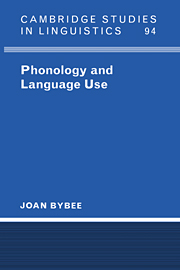Book contents
- Frontmatter
- Contents
- List of Figures
- List of Tables
- Acknowledgments
- 1 Language Use as Part of Linguistic Theory
- 2 A Usage-Based Model for Phonology and Morphology
- 3 The Nature of Lexical Representation
- 4 Phonological Processes, Phonological Patterns
- 5 The Interaction of Phonology with Morphology
- 6 The Units of Storage and Access: Morphemes, Words, and Phrases
- 7 Constructions as Processing Units: The Rise and Fall of French Liaison
- 8 Universals, Synchrony and Diachrony
- References
- Author Index
- Subject Index
- Languages Index
1 - Language Use as Part of Linguistic Theory
Published online by Cambridge University Press: 03 December 2009
- Frontmatter
- Contents
- List of Figures
- List of Tables
- Acknowledgments
- 1 Language Use as Part of Linguistic Theory
- 2 A Usage-Based Model for Phonology and Morphology
- 3 The Nature of Lexical Representation
- 4 Phonological Processes, Phonological Patterns
- 5 The Interaction of Phonology with Morphology
- 6 The Units of Storage and Access: Morphemes, Words, and Phrases
- 7 Constructions as Processing Units: The Rise and Fall of French Liaison
- 8 Universals, Synchrony and Diachrony
- References
- Author Index
- Subject Index
- Languages Index
Summary
Substance and Usage in Phonology
This book introduces into the traditional study of phonology the notion that language use plays a role in shaping the form and content of sound systems. In particular, the frequency with which individual words or sequences of words are used and the frequency with which certain patterns recur in a language affects the nature of mental representation and in some cases the actual phonetic shape of words. It is the goal of the present work to explore to the extent possible at the present moment the nature of the relation between the use of linguistic forms on the one hand, and their storage and processing on the other.
To someone approaching linguistics from other disciplines, it might seem odd that language use has not been taken into account in formulating theories of language. However, since language is such a complex phenomenon, it has been necessary to narrow the field of study to make it manageable. Thus we commonly separate phonology from syntax, synchrony from diachrony, child language from adult language, and so on, constantly bearing in mind that interactions exist that will eventually have to be taken into account. We then go on to formulate theories for these domains – a theory of syntax, a theory of phonology, a theory of language acquisition – knowing all the while that the ultimate goal is to encompass all these subfields in one theory of language.
Early in the twentieth century, a proposal was made to distinguish the shared knowledge that a community of speakers has from the actual uses to which that knowledge is put (de Saussure 1916).
- Type
- Chapter
- Information
- Phonology and Language Use , pp. 1 - 18Publisher: Cambridge University PressPrint publication year: 2001
- 1
- Cited by



